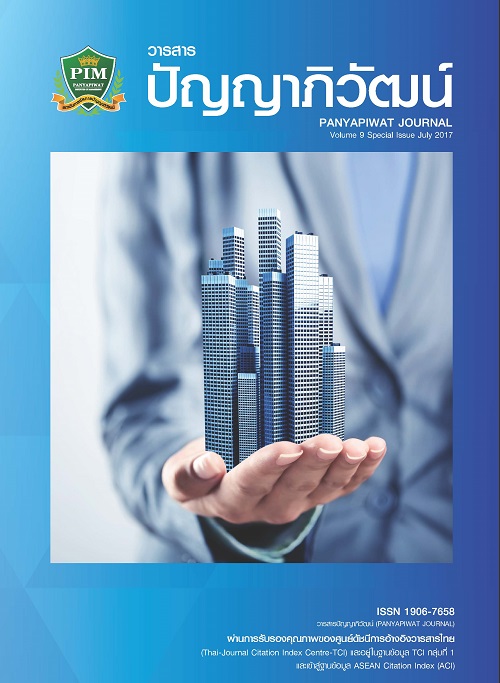ผลของการจัดการเรียนการสอนแบบมีส่วนร่วม Participatory Learning Process (PLP) เพื่อกระตุ้นให้นักศึกษาเข้าเรียนตรงเวลา
Main Article Content
บทคัดย่อ
การวิจัยครั้งนี้เป็นการศึกษาผลของการจัดการเรียนการสอนแบบมีส่วนร่วมเพื่อกระตุ้นให้นักศึกษาเข้าเรียนตรงเวลาและศึกษาความพึงพอใจของนักศึกษาต่อวิธีการเรียนรู้แบบมีส่วนร่วมกลุ่มนักศึกษาที่ใช้ในการทดลองเป็นนักศึกษาชั้นปีที่ 1 ปีการศึกษา 2558 จำนวน 49 คน คณะอุตสาหกรรมเกษตรกระบวนการทดลองทั้งหมดใช้เวลา 9 สัปดาห์โดยแบ่งออกเป็น 2 กลุ่มคือ 1) สัปดาห์ควบคุม: คณะผู้วิจัยจัดการเรียนการสอนแบบปกติจำนวน 1 สัปดาห์ 2) สัปดาห์ทดลอง: คณะผู้วิจัยจัดการเรียนการสอนแบบมีส่วนร่วมจำนวน 8 สัปดาห์เครื่องมือที่ใช้ในการวิจัยประกอบด้วยแผนการจัดการเรียนการสอนที่ได้รับการออกแบบจากคณะผู้วิจัย สถิติการเข้าชั้นเรียนของนักศึกษาในวิชาฟิสิกส์เพื่อการจัดการสภาพแวดล้อมในฟาร์มและแบบสอบถามความพึงพอใจของนักศึกษาต่อการจัดการเรียนการสอนแบบมีส่วนร่วมผลการวิเคราะห์ค่าสัมประสิทธิ์ความเชื่อมั่นโดยวิธีแอลฟ่าของครอนบัค (Conbrach’s Alpha Method) ได้ค่าความเชื่อมั่น 0.96 ซึ่งถือว่าเป็นค่าที่ยอมรับได้โดยแบบสอบถามจะครอบคลุมประเด็นต่างๆเช่นบุคลิกภาพของอาจารย์ผู้สอนวิธีการสอนกิจกรรมการเรียนการสอนสื่อการสอนบรรยากาศในห้องเรียนโดยคณะผู้วิจัยจะนำข้อมูลที่ได้รับจากแบบสอบถามไปวิเคราะห์โดยใช้สถิติพรรณาเชิงตัวเลขนอกจากนี้คณะผู้วิจัยใช้การทดสอบไคสแควร์เพื่อเปรียบเทียบในแต่ละสัปดาห์ของการจัดการเรียนการสอนทั้ง 2 กลุ่มว่า นักศึกษาเข้าเรียนตรงเวลาหรือไม่ผลการวิจัยพบว่า 1) ผลของการจัดการเรียนการสอนแบบมีส่วนร่วมทำให้นักศึกษามีความกระตือรือร้นในการเข้าชั้นเรียนตรงเวลาเพิ่มขึ้นเมื่อเปรียบเทียบกับการจัดการเรียนการสอนแบบปกติที่ระดับนัยสำคัญ 0.05 2) คะแนนภาพรวมความพึงพอใจของนักศึกษาต่อการจัดการเรียนการสอนแบบมีส่วนร่วมอยู่ในระดับมาก (µ=4.43, σ=0.64)
This study investigates the effect of using Participatory Learning Process (PLP) to motivate students attending class on time and to evaluate the students’ satisfaction on participatory learning process. The subject of this study was conducted on forty-nine first year students, in 2015 academic year, Faculty of Agro-Industry. The treatment process took nine weeks in total. Nine weeks were assigned into two groups: the control week (1-week) was taught by using traditional learning process while the experimental weeks (8-week) were taught by using participatory learning process. In this study, the instruments were used: First, lesson plan was designed by the researcher to provide students with explicit instruction on participatory learning activities. Second, statistical data analysis was analysed from class attendance by using room tracking system. Third, to measure the students’ learning satisfaction on participatory learning process, we used a students’ learning satisfaction questionnaire which was related to many important aspects such as the instructors’ personality, learning approaches, learning activities, learning resources, classroom environment. The Cronbach’s alpha reliability coefficient of this questionnaire was reckoned at 0.96. The satisfaction data collected were analysed by using descriptive statistics. In addition, Chi-square test was used to determine whether the students attend the class on time comparing between both two groups. The results are 1) Using participatory learning process, students are more enthusiastic to attend class on time compared to traditional learning process at 0.05 significant level. 2) The average overall student satisfaction scores on participatory learning process were at high level of satisfaction (µ=4.43, σ=0.64).
Article Details
“ข้าพเจ้าและผู้เขียนร่วม (ถ้ามี) ขอรับรองว่า บทความที่เสนอมานี้ยังไม่เคยได้รับการตีพิมพ์และไม่ได้อยู่ระหว่างกระบวนการพิจารณาลงตีพิมพ์ในวารสารหรือแหล่งเผยแพร่อื่นใด ข้าพเจ้าและผู้เขียนร่วมยอมรับหลักเกณฑ์การพิจารณาต้นฉบับ ทั้งยินยอมให้กองบรรณาธิการมีสิทธิ์พิจารณาและตรวจแก้ต้นฉบับได้ตามที่เห็นสมควร พร้อมนี้ขอมอบลิขสิทธิ์บทความที่ได้รับการตีพิมพ์ให้แก่สถาบันการจัดการปัญญาภิวัฒน์หากมีการฟ้องร้องเรื่องการละเมิดลิขสิทธิ์เกี่ยวกับภาพ กราฟ ข้อความส่วนใดส่วนหนึ่งและ/หรือข้อคิดเห็นที่ปรากฏในบทความข้าพเจ้าและผู้เขียนร่วมยินยอมรับผิดชอบแต่เพียงฝ่ายเดียว”
เอกสารอ้างอิง
Department of Mental Health. (2001). Participatory Training Manual (4th ed.). Bangkok: Wongkamol Production. [in Thai]
Domínguez, R. G. (2012). Participatory Learning. In N. M. Seel (Ed.), Encyclopedia of the Sciences of Learning (pp. 2556-2560). Heidelberg, Germany: Springer-Verlag.
Johnson, D. W., Johnson, R. T. & Holubec, E. J. (1994). Cooperative learning in the classroom. Alexandria, VA: Association for Supervision and Curriculum Development.
Kimsungnoun, N. (2014). An effect of participatory learning method in the subject of community health nursing on learning achievement of nursing students, School of Nursing, Rangsit University. Journal of Rangsit University: Teaching & Learning, 8(2),78-88. [in Thai]
Kohle, K. (1982). Freedom, peace and personality. Education: A Biannual Collection of Recent German Contribution to the Educational Research, 24.
Office of the Council of State. (1999). National Education Act of B.E. 2542. Retrieved July 5, 2016, from http://www.onesqa.or.th/upload/download/file_975dff739ff5a909753b8bff237c78fa.pdf[in Thai]
Promboon, S. & Pornsima, O. (2006). The theory of participatory learning. Bangkok: Office of the National Education Commission. [in Thai]
Takuathung, O. N. (2002). Differentiated instructional strategies. Bangkok: Expernetbooks. [in Thai]
Wanganuphap, Y. (2002). The study of undergraduate students’ learning achievement in the subject of Human Relations in Organization conducted by participatory teaching methods, Chandrakasem Rajabhat Institute. Bangkok: Chandrakasem Rajabhat Institute. [in Thai]


